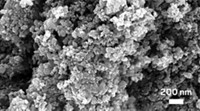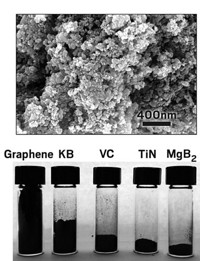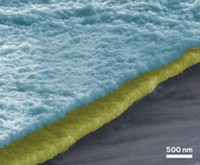Advertisement
Grab your lab coat. Let's get started
Welcome!
Welcome!
Create an account below to get 6 C&EN articles per month, receive newsletters and more - all free.
It seems this is your first time logging in online. Please enter the following information to continue.
As an ACS member you automatically get access to this site. All we need is few more details to create your reading experience.
Not you? Sign in with a different account.
Not you? Sign in with a different account.
ERROR 1
ERROR 1
ERROR 2
ERROR 2
ERROR 2
ERROR 2
ERROR 2
Password and Confirm password must match.
If you have an ACS member number, please enter it here so we can link this account to your membership. (optional)
ERROR 2
ACS values your privacy. By submitting your information, you are gaining access to C&EN and subscribing to our weekly newsletter. We use the information you provide to make your reading experience better, and we will never sell your data to third party members.
Energy Storage
New electrolyte improves Li-S batteries
Made from a lithium salt and diglyme, the electrolyte keeps troublesome sulfur reactions in check and thwarts formation of harmful lithium dendrites
by Mitch Jacoby
August 16, 2018
| A version of this story appeared in
Volume 96, Issue 33
Lithium-sulfur batteries can pack up to five times as much energy by weight as some lithium-ion batteries, in principle. In practice, experimental versions of the batteries have fallen short of expectations because of unwanted chemical reactions between the electrodes and the electrolyte solution that alter the electrodes, thereby reducing energy storage and shortening battery life.
Rather than trying to solve these problems by modifying the electrodes, as many researchers have done, a team led by Quanquan Pang and Linda F. Nazar of the University of Waterloo have come up with a promising alternative approach. The team designed a customized electrolyte solution that limits these destructive reactions and suppresses battery degradation (Nat. Energy 2018 DOI: 10.1038/s41560-018-0214-0).
Lithium polysulfides are well-known bad actors in Li-S battery chemistry. The species, which dissolve in electrolyte solutions, shuttle between the cathode and anode, removing electrochemically active cathode material and corroding the anode. So the Waterloo team designed an electrolyte that barely dissolves polysulfides, and they used it sparingly in a Li-S battery. The electrolyte they arrived at contains the solvent diglyme and a lithium salt.
The team found that the electrolyte solution mediates the ionic reactions needed to drive the battery steadily for over 100 charge cycles but confines the sulfur chemistry to a quasi-solid state. The team also found that upon repeated charging, the electrolyte facilitates smooth deposition of lithium on the anode, avoiding formation of lithium dendrites, which can cause safety and battery degradation problems.





Join the conversation
Contact the reporter
Submit a Letter to the Editor for publication
Engage with us on Twitter